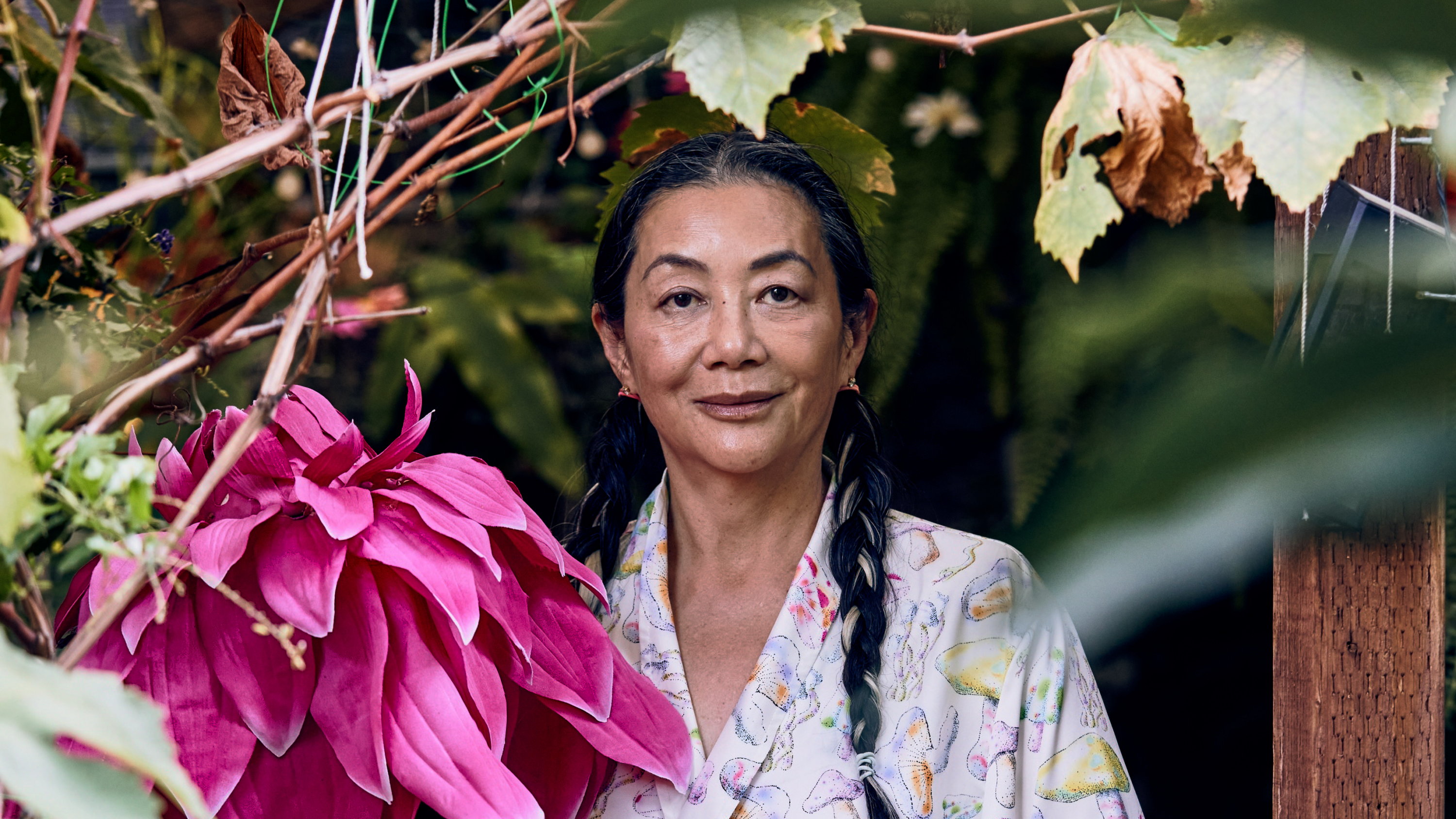Your creative career has taken so many different shapes. Can you give us a snapshot of what you’ve done, and how you got to where you are now?
Well, I’m a Canadian. I came down to Los Angeles to go to ArtCenter [College of Design]. I graduated with a major in fine arts—ha! Like that’s so useful—and a minor in photography. Luckily, I had photo skills. I started shooting for [the magazine] Ray Gun, and because I was shooting a lot of music and fashion, the music labels found me. I started shooting for them in the mid-’90s. From there I got hired by record labels to be the art director and then got grabbed to be the creative director for an independent film distributor. We had a lot of films in a lot of festivals—Sundance, New York, Berlin, Toronto. Niche films were my specialty; LGBTQ and a lot of foreign films—Russian, French, German, and directors like Gaspar Noe and Cindy Sherman. I did that for quite a while. Then I was the creative director of the Slamdance Film Festival for 10 years, as well as LAIFF and Outfest. Then I got snagged again into book publishing. From there, I discovered cannabis and the racism that was on both sides of the fence, within the cannabis industry and those opposing it. So, I created Stock Pot, a stock imagery agency that specialized in authentic photos of cannabis culture.
What kind of racism did you encounter in cannabis?
In January 2015, a family member was looking into the use of cannabis. I was new to it too, so I did a little research. I typed “weed smoker” into Getty Images, a billion-dollar company. If it was a photo of a Black man, the keywords that came up were addict, criminal, drug dealer, homeless. If it was a white dude, you didn’t get those keywords. That’s how I started in cannabis. From that, I grew Stock Pot to over 250 photographers—men, women, Black, brown, everybody. And the images I curated were of real cannabis users—older people, younger, LGBQ, trans, children, cats, dogs, chickens, horses, families, everything of every color, plus the largest library of distinct cannabis strains.
But mostly the impetus for creating Stock Pot was the racism of the people outside of cannabis and how they looked at patients. Because my family member was going to be one of those patients. I started seeing how they would see her, and then I discovered that the Asian community is extremely anti-cannabis. So I started Asian Americans for Cannabis Education to educate the people on my side about cannabis by interviewing people who went to Harvard, Duke, and MIT, doctors—everything about why they’re in cannabis—to show that you can have a degree, you can have a great living, and they don’t look like what you think [cannabis supporters] look like.
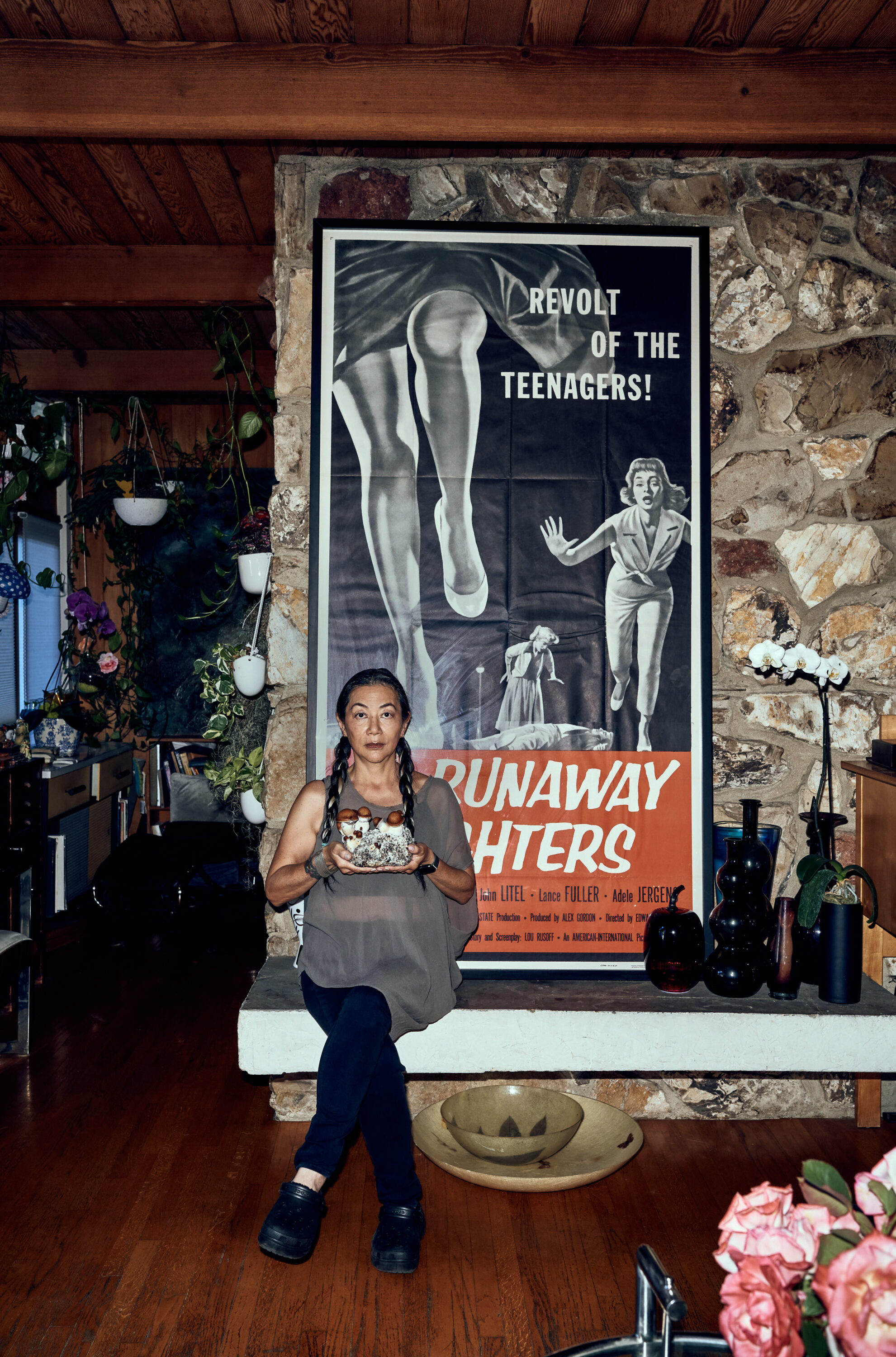
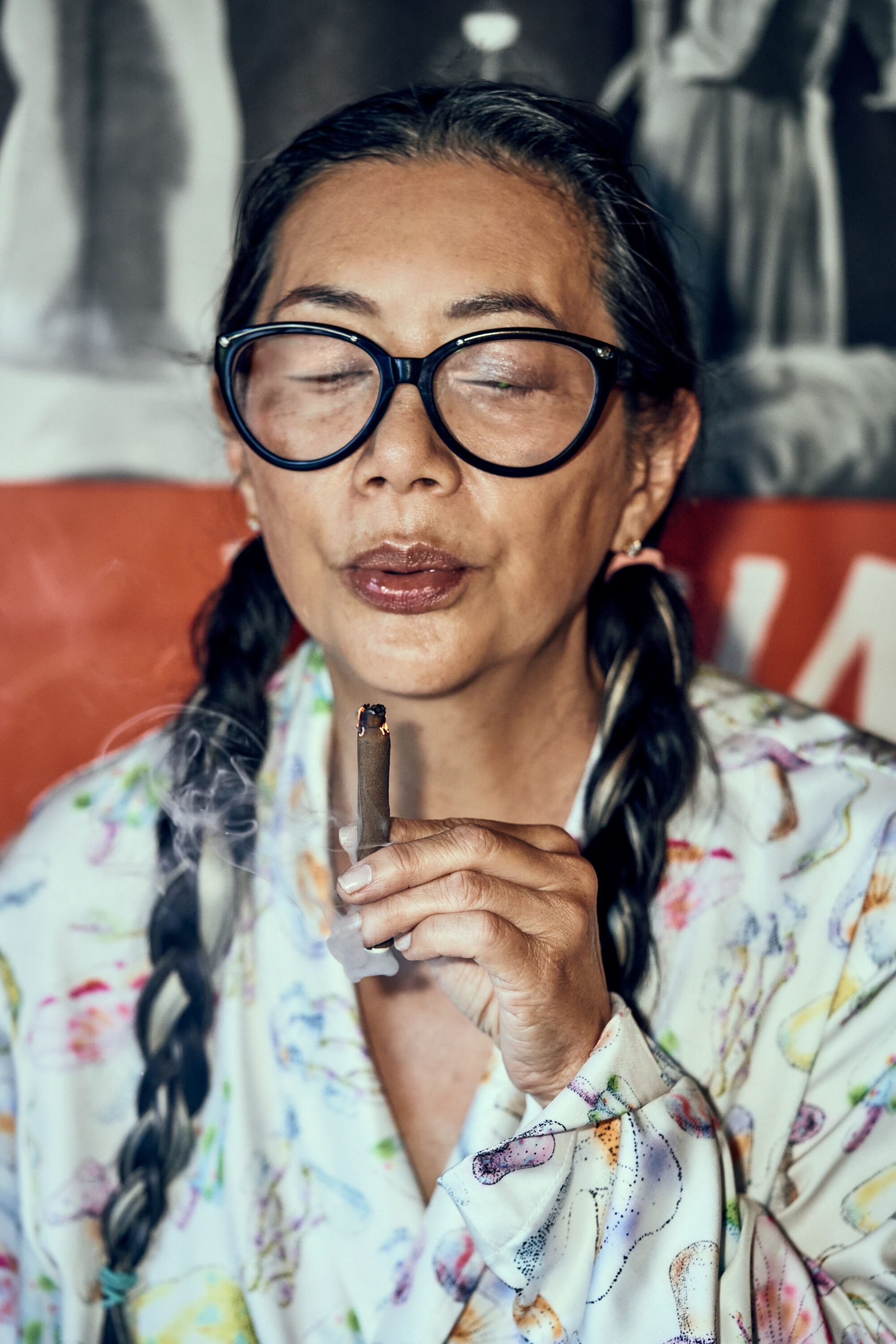
After getting the idea to combat racism through stock imagery, how did you take that kernel of inspiration and turn it into a viable company? What were some of the challenges?
Well, I’m not a creator or an entrepreneur, I love working for people. So doing this was completely… I had to learn so much—creating an LLC on LegalZoom, getting QuickBooks and learning accounting, hiring all the people to build the website, the way to store the images and keywords. But luckily, the training I had in photography allowed me to understand composition and imagery.
In the second year, Adobe came to me. They were creating a stock photo agency within Adobe so they partnered with me because they saw cannabis coming up. Then in December 2019, I decided to shut Stock Pot down. In January 2015, when I created it, there were only two states that had some legalization, Colorado and Washington. Everything in California was still illegal, and therefore you couldn’t get on farms, you couldn’t get into a lab, you couldn’t take photos in a dispensary. I had to overcome all those blocks by talking to people, by going to farms, by going to every event and becoming friends and having them trust me.
Then Prop 64 came in 2017 in California and exploded. Everyone was growing, and then 28 states came after that. Then everyone had access to photograph weed, whereas before, I had to build so much trust with these farmers and labs and stores to be able to shoot. Now it was open, so all the other places—Getty, Alamy, Shutterstock—had a flood of images, which dropped my prices. Even the best shooters at Getty get only 10 percent; if they license a dollar photo, they get 10 cents. My photos all started at $25 up to thousands, and the photographers got 50 percent of each image. I respected the artist’s rights over the licensee. But Getty and all the other image places basically undercut me by thousands of percentage points.
What’s been your focus since you shut Stock Pot down?
When I created Stock Pot, we specialized in cannabis, but then I saw hemp coming up, and the use of hemp to produce CBD for pain relief. So we also did hemp. Then in 2016, I also saw psilocybin and mushrooms trending, their benefits coming up in medical studies at Yale and Harvard and John Hopkins. It was very hard to find images of magic mushrooms that were high quality. So I had to grow my own mushrooms, and I started in my bedroom. When I launched Stock Pot, I learned everything about cannabis, from the seed to trimming to curing. Same thing with mushrooms. I learned on Reddit and YouTube and through self-published books, and became good enough that the magazine Double Blind came to me to create their Mushrooms 101 class, How to Grow Mushrooms. Over 5,000 people have taken that class. I learned as much as I could about psilocybin and mushrooms—I found my passion and it became a full-time hobby. In the last seven years, I’ve been cultivating functional mushrooms on my own, growing and learning and creating genetics. Cannabis, hemp, and mushrooms were all running parallel.
It’s like with Asians, you can’t go home to Thanksgiving if you only have three jobs, then you’re a loser. You’ve got to have at least five or six. Right now, I specialize in genetics to learn more about fungi, and be able to provide edible mushrooms; my specialty is farm-to-table. Because when you’re buying drugs, you’re taking a big leap of faith. What I offer is everything from my hands into theirs. There’s no break in the chain of production. They know that everything’s clean and organic and made with care.
You said you are not a natural entrepreneur. But clearly it’s working for you. When you launched Stock Pot, what was that transition like? Was it uncomfortable?
It was horrible! For someone who failed math in high school, two years in a row? Having to run a business and thinking, Oh my God, I’ve got to hire an accountant. I’ve got to do QuickBooks. I’ve got to enter all this stuff. It was mind-numbing and I was keywording every day—I would be doing almost 300 images a day on top of everything else. So, I was run ragged. Plus, I made the investment to go and speak at conferences. I was a little bit of a unicorn. Most of the people in cannabis, if they’re growing or lab, they’re all white men. Black and brown didn’t go into cannabis, ’cause they’re the first ones to get arrested. So there are very few people of color, and I fit two check marks, female and Asian. I got asked a lot to speak on panels, and that’s how I was able to also expand the business by making that effort and paying my own way. I had to learn to do all of that. Before I was very private and more quiet, but then I had to actually put myself out there, and it’s very hard because I don’t ask people for help at all. So, I have to learn everything and do everything on my own. I don’t know if that’s a female thing or just being stubborn, but that is one of my biggest failings.
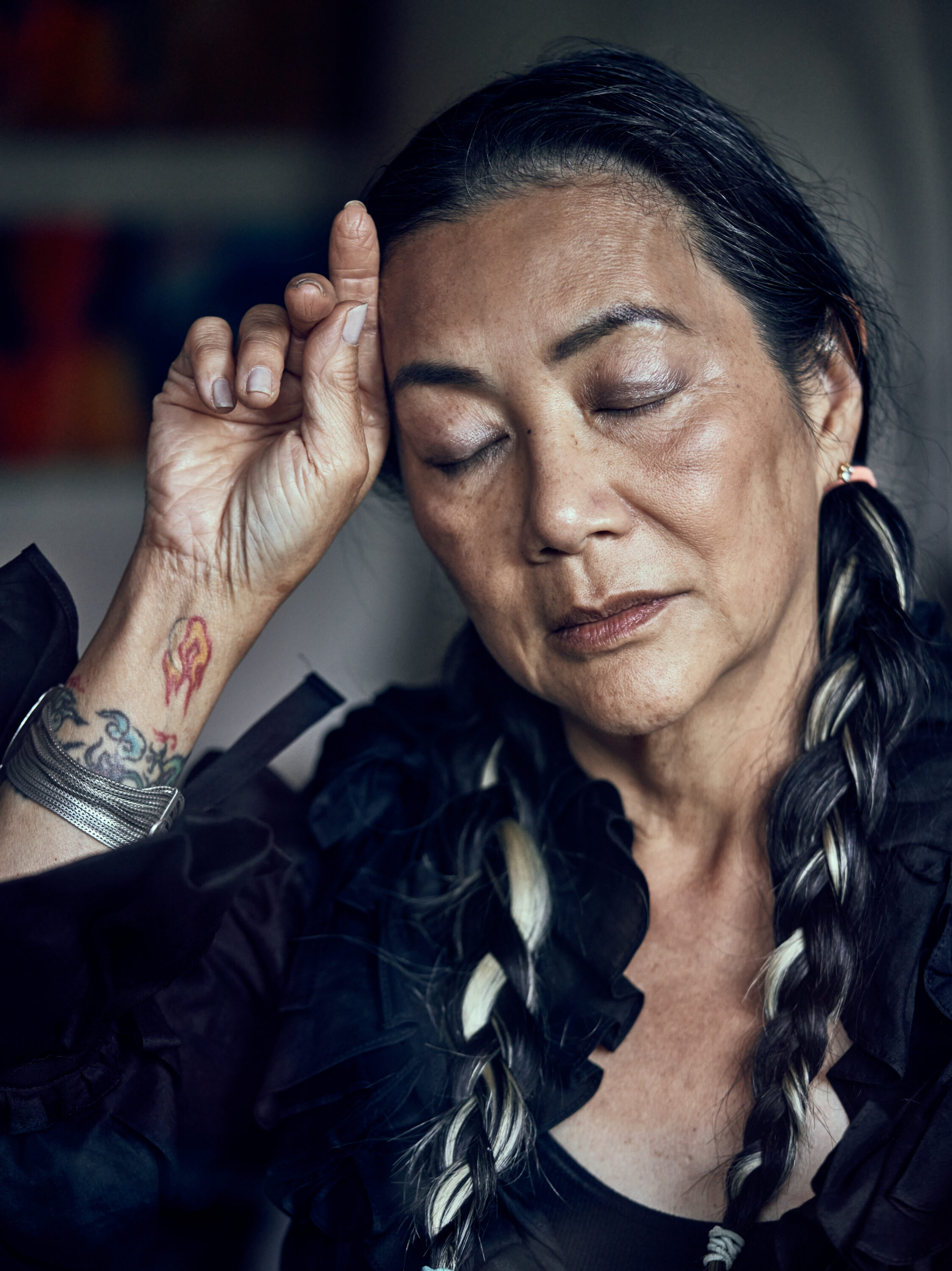

It feels like so much is changing in creative fields. Do you find that stressful or exciting?
I think it’s stressful because it’s changing people mid-career. It would be exciting if you were a 12-year-old, or if you were in college. Everything’s in its infancy—Chat GPT, right? But the more we use it, the more it learns. Just like Google. I remember in 1996, one of my stocking stuffers from a friend was the white pages of HTML addresses. Isn’t that hilarious? It was all the URLs. It was only about this thick [makes a small space between thumb and forefinger]. So that’s what, 27 years ago? And here we are now. I think all this stuff, AI and chat GPT, for creatives, it’s very exciting if you’re 12 years old, but 30 and up, you have to learn it very quickly. Your career, my career, we’re competing with a human element where they want it all for free. “Look, I can just get that image from Instagram. Why should I pay you?” Or “Look, I can just put a mess of words in Chat GPT.” We’re competing with two things: the machine and humans. Humans who don’t value creativity and want to pay for it. And the machine that’s just going to do what they want.
You seem well versed in adapting to that kind of change though. Not just going with the flow but seeing the future and where you want to be going with it. What advice would you give to other people who are in this fluctuating phase of trying to figure out what to do next and where their creativity should take them?
There are so many ways to answer that question. Because a lot of the stuff I did was an epiphany, like, “Oh, shit, I’ll just do it.” Other ones were, “Hey, do you want to work with us?” I’ve been very lucky, I would just say, “Okay, I’ll do it.” And just in the last seven years, it was more creating—Hey, you like doing this, so why don’t you make some money from it? The only boundaries that exist are if you want to do something, and it’s not readily available. But every time I want to do something, it pops up.
I’ve always loved growing things. So with the mushrooms, things just kept growing and growing and the community got bigger. I believe in medicine for the people, that’s why I do cannabis too, because a family member was using it for medicine. Same with mushrooms and psychedelics. MDMA, DMT, ketamine, and psilocybin are all in a toolkit for trauma. Even though it is hard to share with those in need, I’ve seen how it’s helped people, and I’ve seen how cannabis and other plant medicines in the Traditional Chinese Medicine history have helped people. This is just an extension of that. God, who knew I would be ending my career in a Schedule 1 industry? [laughs]
You mentioned that you’ve always loved growing things. Can you tell me more about that?
Well, it’s historical too. Because the Chinese are agrarian, we grow a lot of food. That’s our main thing. Everyone had their own vegetable patch, even growing up in Canada. It was very hard to get certain Chinese vegetables, so my dad would get seeds from other people in the community. That brings to mind too, when we share spores or liquid culture within the mushroom community, it’s the same thing every other culture does with seeds. Say you immigrated here from Syria or Somalia or Mexico, there are certain herbs and vegetables that you can’t get here, so you go within your own community to get those seeds. That is what we do in mushrooms too. Within our community, we try to get the genetics that will help people. And that has been in my DNA forever. From being a child and watching my dad get seeds from other people to grow in our backyard. I’m doing the same thing with mycelium spores. It’s a full circle. The only difference is one is legal and one is not.
And why is that? That goes back to Chinese culture too. In the early 1960s, the UN went to China and said, you can be part of the UN if you adopt certain aspects of our common thinking. And one of them was Schedule 1 drugs, which are heroin, coke, meth, cannabis, psilocybin, ketamine, and a few other things. Two of those things, mushrooms and cannabis, have been in our traditional Chinese medicine for over 5,000 years. The mushrooms were called mógū, which translates to the giggly mushroom, and cannabis is mágū. In 1960 we were told we can’t use them anymore. So for me now in the 2000s, I’m actually growing two of the Chinese medicine cabinet staples, which were made illegal.
With AACE, you do a lot of work towards cannabis education in the Asian community. Do you find that you’re doing that with psilocybin too? Is there the same kind of stigma?
When it comes to mushrooms, there is no hesitation. Because in my community, we see it as medicine. We know the benefits and we know the benefits of microdosing.
But the birth of Stock Pot images was because my relative was sick. It wasn’t because I’m a weed smoker. I’ve been 18 years sober from alcohol. It was because this family member was going to be stereotyped, and so I wanted to create something that killed that stereotype with images that were true and of real people. I’ve never made a lot of money. I’ve done well, but everything I did was not for money, which is why I always said, “Okay, I’ll take that job.” I never asked how much it paid. I just thought it sounded interesting.
I didn’t go into cannabis and psilocybin for monetary reasons. It’s done because I see the benefit as medicine, but also to help the fight against racism and stereotyping and ignorance and misinformation. Everything else that came from it was a huge benefit, like really getting back into my roots of learning and growing from seeds and spores. I grow a lot of functional mushrooms too—pink oysters, lion’s mane, reishi, turkey tail. My neighbors were all flooded with mushrooms during Covid, because I had so many. I just made bags and bags of pink oyster mushrooms, they were all over the house.
As someone who grew up in Toronto, what made you want to come to the U.S. for art school?
I wanted to get out of the snow. Also, I met someone who was an American citizen, and he proposed to me after nine months. He was Chinese. He’s a librettist, he’s written a lot for Broadway. So, he said, “Do you want to go to New York or do you want to go to L.A.?” And I said, “L.A. because it’s hot and sunny.” I came down here, applied to ArtCenter and got in, and I just never left.
How has being in L.A. influenced your creative path?
Because you can grow stuff 24/7 here. I would be so unhappy if I were staring at snow and dead plants because I go outside every day and just stare at my garden, it’s a form of meditation. I just go in there and I see the butterflies and hummingbirds. That’s a respite from noise. If I had to stare at snow, which I’ve done, I would be so depressed. There was one time when I was a kid in Toronto, and it snowed in May. I started crying because we’d already had eight months of snow. I was like, No, no, we can’t do this!
But Canada’s very open. I mean, they were the first to legalize weed and mushrooms. We’re doing it slowly here, where you can hold it, but you can’t manufacture, distribute, or grow it. I always ask the question, then how did you get it in your hand, right? Where did it come from, magic? It’s baby steps.
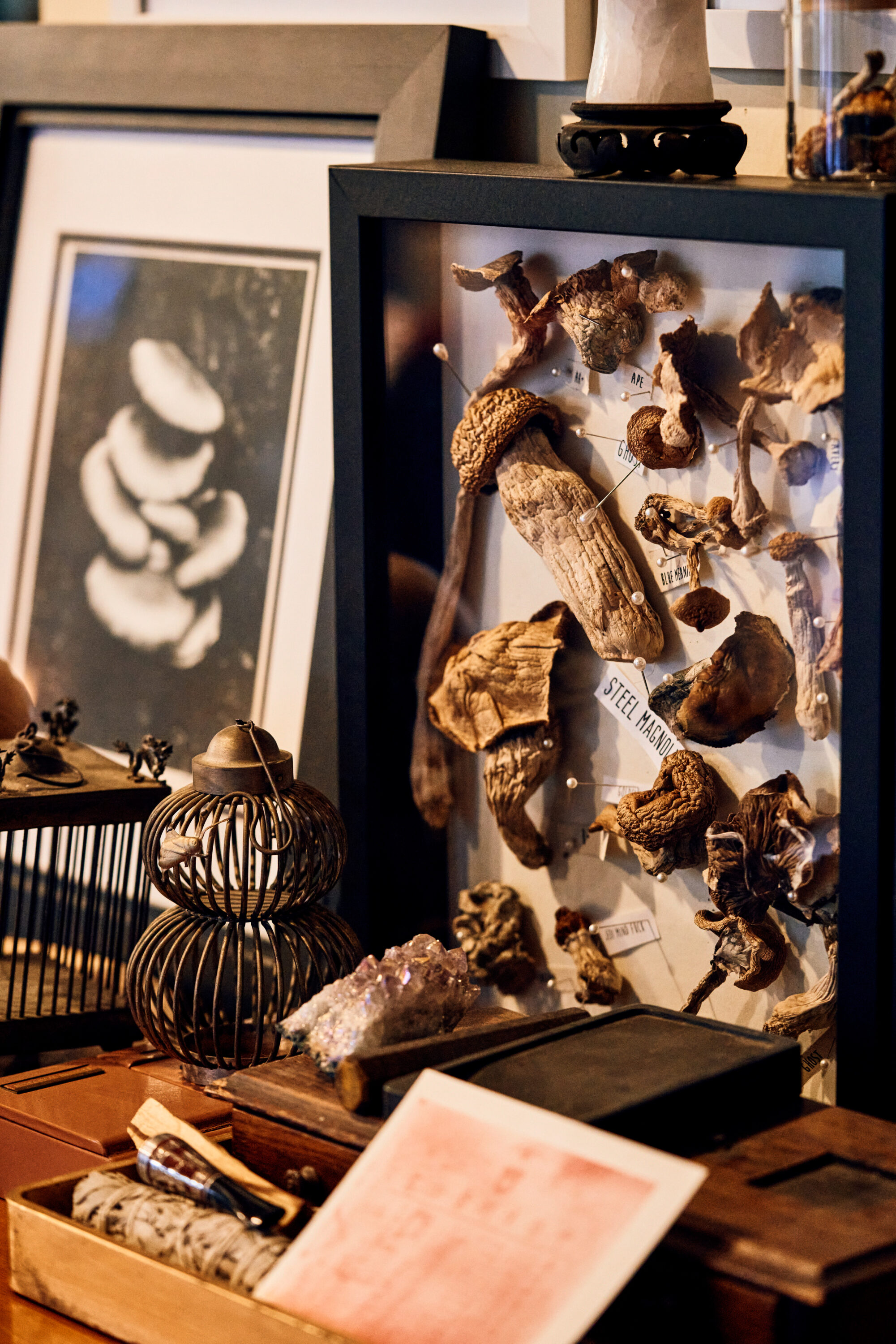
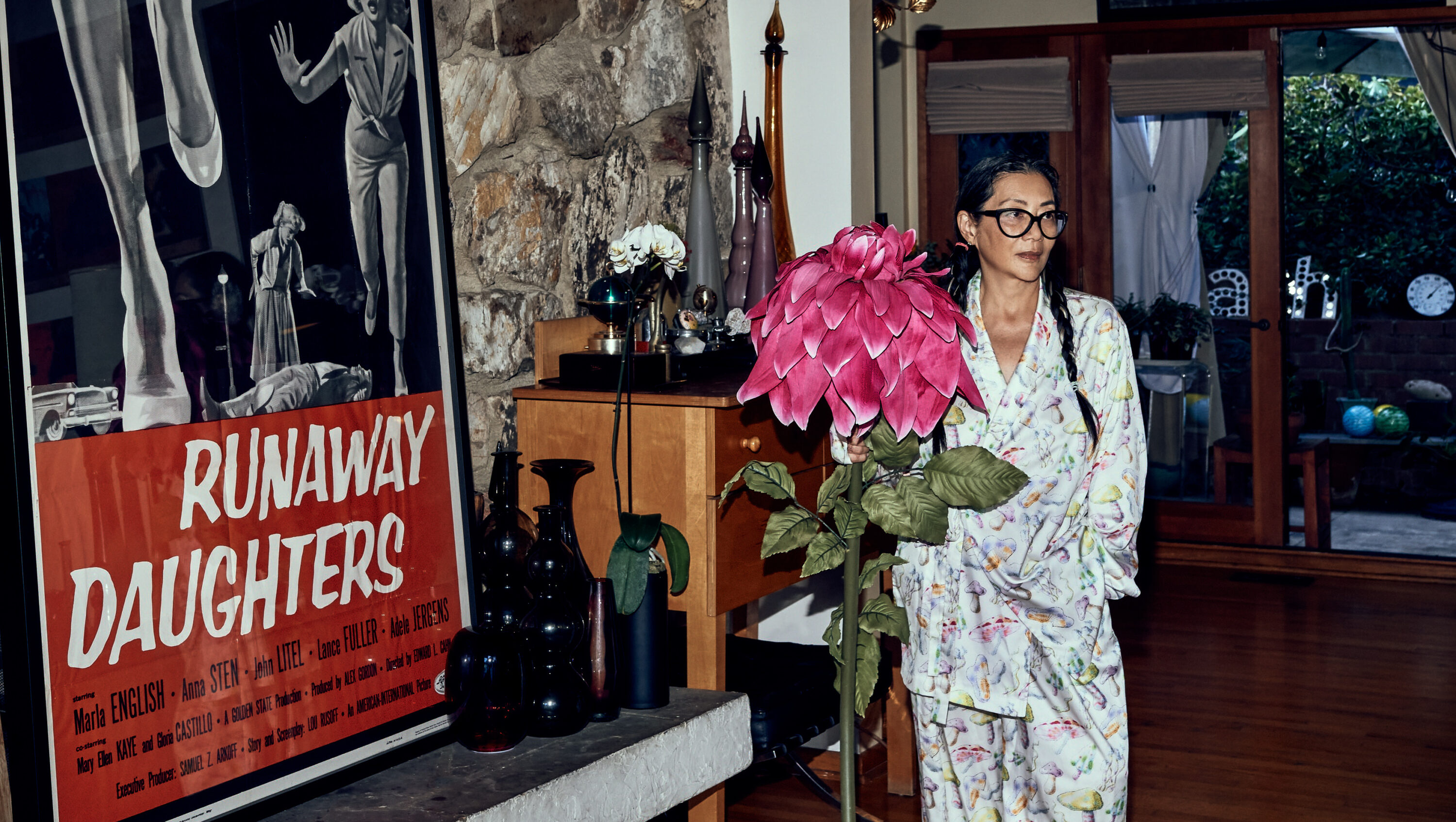
Has your interest in social impact always crossed paths with your creativity?
I’ve always been an organizer. My biggest passion is putting people together. With AACE, that was putting Asians together with cannabis—let’s teach each other that this is just a plant, and you’re not a stoner. With psilocybin, it is, “Why are we denying our medical heritage, traditional Chinese medicine?” For two years I taught art at LAMP Community [a nonprofit providing support and shelter to unhoused men] in Skid Row. I would go down every Tuesday and I’d bring supplies and we’d do journaling. It was really fun because it was really great getting to know all these people. I just like being in community, whether it’s teaching in Skid Row or teaching at a college level, organizing AACE, getting people together for little mushroom talks. I think I just want to inform people because right now, we’re in a deep stew of misinformation. So my thing is, if I can chip away at it, just a tiny little chip here and there in a tiny little community, I’m doing my part.
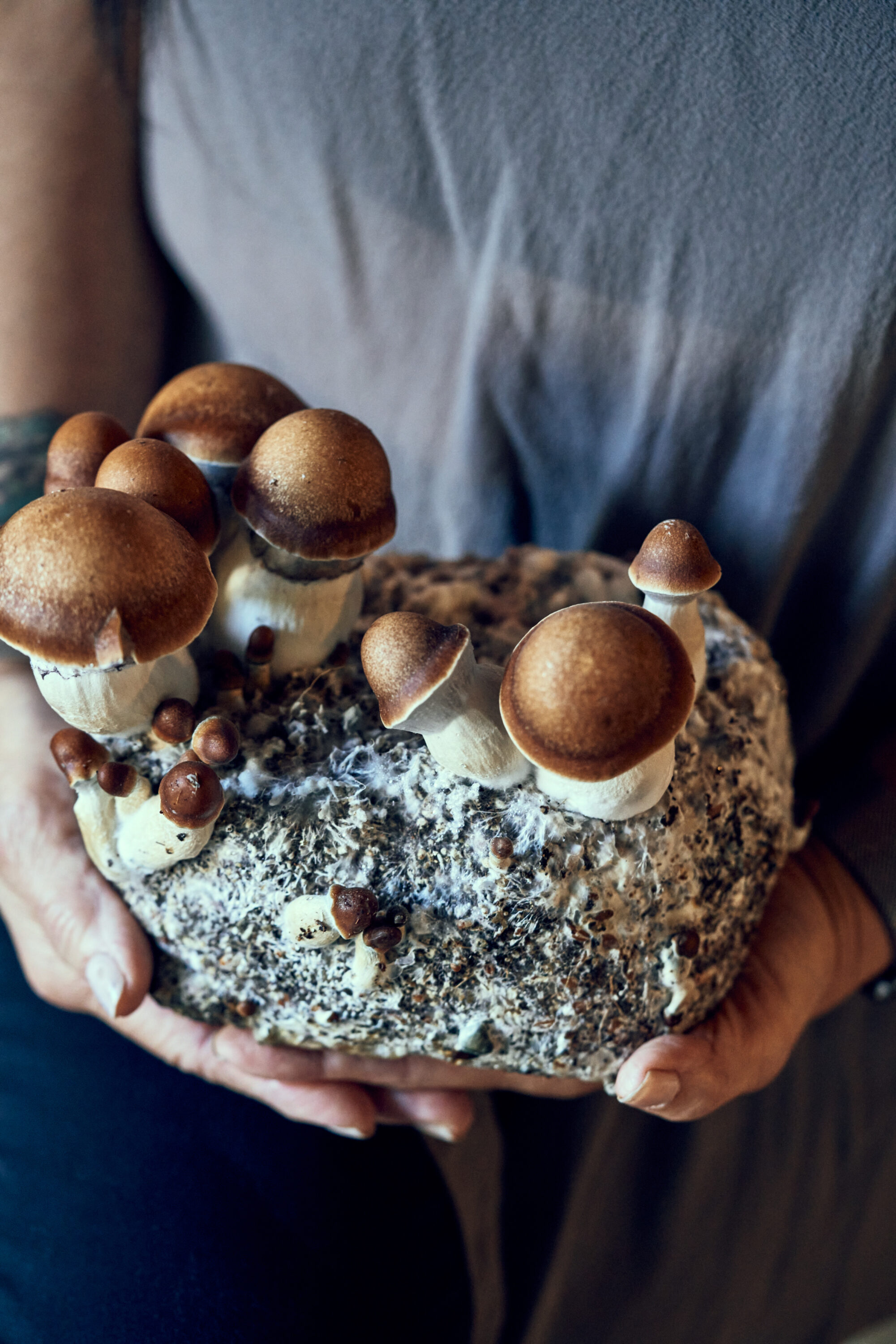
Does your work in cannabis and psilocybin influence other areas of your creative life?
I’m working with this Los Angeles gallery artist Theodore Boyer. He’ll be painting on giant sheets of blotter paper, and I’ll infuse it with acid, and we’ll put it behind glass. The premise is art is visual, but what if it was visual internally? What if you could eat a little tab off his art and then see this art in a completely three-dimensional way, with what’s in your head? Theo’s offering you the foundation, but then when you trip, you’re actually seeing the painting, your mind sees it. There are other ones, too. I’m working with a bunch of musicians now that have albums coming out. I just sent one off to the south of France with a psychedelics kit to help him record in a studio for the next two weeks. So those are examples of what I do. I go in there and expand other people’s way of thinking of how to be more creative. And help them expand this part [touches her head], but also help them deal with the trauma that is possibly roadblocking more creativity.
And it seems like for you growing mushrooms is a creative process in and of itself.
Oh yeah. This is my paint; these are my brushes. I’m creating art that is internal for you, and only you can see that art because it’s your experience. It’s like, here is your art. Disconnect. Or more, connect with what you’re afraid to connect with.
